New Book Releases / Autumn 2022
If you want to signal a recent or forthcoming film publication for the next round-up in winter, please contact Ruben Demasure. For notes on more books, see David Hudson’s monthly round-up at Criterion’s The Daily.
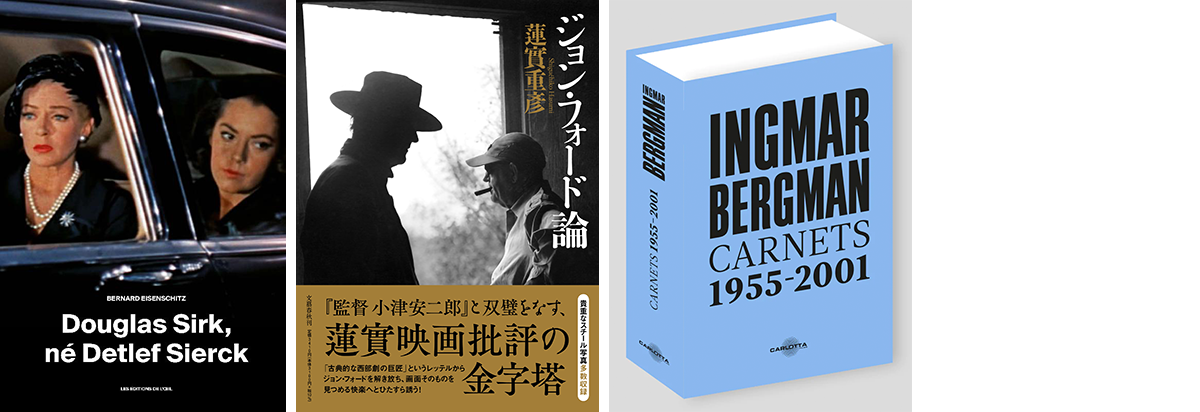
A new book by French film critic and historian Bernard Eisenschitz is always an event. Published on the occasion of the first complete Douglas Sirk retrospective at this year’s Locarno Film Festival, Douglas Sirk, né Detlef Sierck is both a biographical and imaginary account of the life and work of the American master of melodrama. Based on Sirk’s archives, deposited in the Cinémathèque suisse in 2014, Eisenschitz was asked to write a work on the German filmmaker who was more American than other American filmmakers. Unlike his compatriot Fritz Lang, his work was recognized much later. Critics did not take notice until the mid-1950s, almost at the same time as the filmmaker’s career came to an end. This book is a new attempt to change that.
The great Japanese film critic and French literature scholar Shigehiko Hasumi has been working on his book on John Ford as one of his life’s works. Theory of John Ford is now finally published, unfortunately at present only in Japanese. As in his important work on Yasujirō Ozu, and his overall criticism in general, Hasumi discusses the “themes” of John Ford, not to be confused with the general “subject” of a film. In Theory of John Ford, those themes include horses, trees, throwing and white aprons. “I am particularly attracted to the significant details that have such tentacles,” Hasumi says, “and I am not interested in a single image without tentacles, no matter how wonderfully composed it may be. For example, the gesture of ‘throwing’ in one of John Ford's works reaches out to ‘throwing’ in other works of Ford. Furthermore, this time the white apron is extending its tentacles to other things. Guided by these tentacles, I see the ‘connection of souls’, that tie shots, films and images to each other.” Let’s hope that a translation will follow soon!
After their translation of Ozu’s notebooks, Carlotta now comes with Ingmar Bergman, carnets 1955-2001. Previously only available in Swedish(!), these diaries are an exploration of the beating heart of creation and give us a poignant self-portrait of an artist on a daily basis, with his moments of euphoria and despondency.
Let’s top off this first batch of new “auteurs”-driven publications with two (semi-)online ventures. A long interview with Joe Dante by critic Gabe Klinger will be published in print and online in September, serving as a kind of postscript to the book Klinger co-edited on Dante in 2013 and to check in with him a decade later. Dante is best known for his work in the 1980s, with Gremlins (1984) at the top of the list, which gave him unrivalled fame in the field of genre cinema. Dante has never ceased to explore the margins of Hollywood production, alongside his career as a director, that of a historian and an informed critic. You can find an excerpt of the interview on the website of Metrograph.
Collin Brinkmann has written a monograph and critical biography of American filmmaker James Gray, “the first of its kind in English”. Leading up to the October 28 release date of Armageddon Time, the fifth of what will be a total of nine weekly installments has now been put up on his website for free.
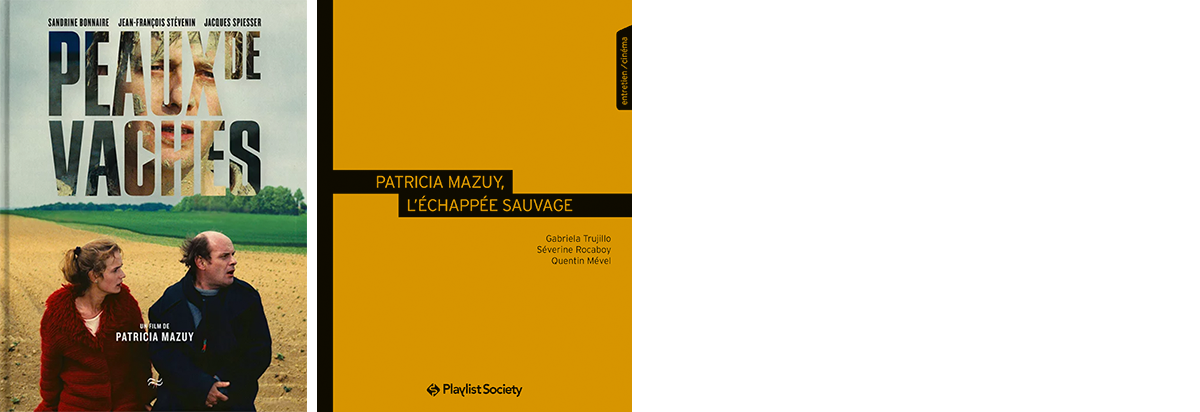
With a new film, Bowling Saturne, and another one that starts shooting next January, the singular French filmmaker Patricia Mazuy is now the subject of two new publications. Les éditions de l’oeil put out a new DVD/Blu-ray edition of her extraordinary debut feature Peaux de vaches (1989), accompanied by a 112-page book which includes photographs of the shooting of the film by Claudine Doury, an account of its making by Mazuy herself, and two interviews with the filmmaker, respectively by Serge Daney and André S. Labarthe. Published simultaneously with the French release of Bowling Saturne on October 26, Patricia Mazuy, l’echappee sauvage is composed of an introductory essay and an interview, and was edited by Quentin Mével, Séverine Rocaboy and Gabriela Trujillo. Published by Playlist Society, the booklet portrays Mazuy as a director who gallops through her time.
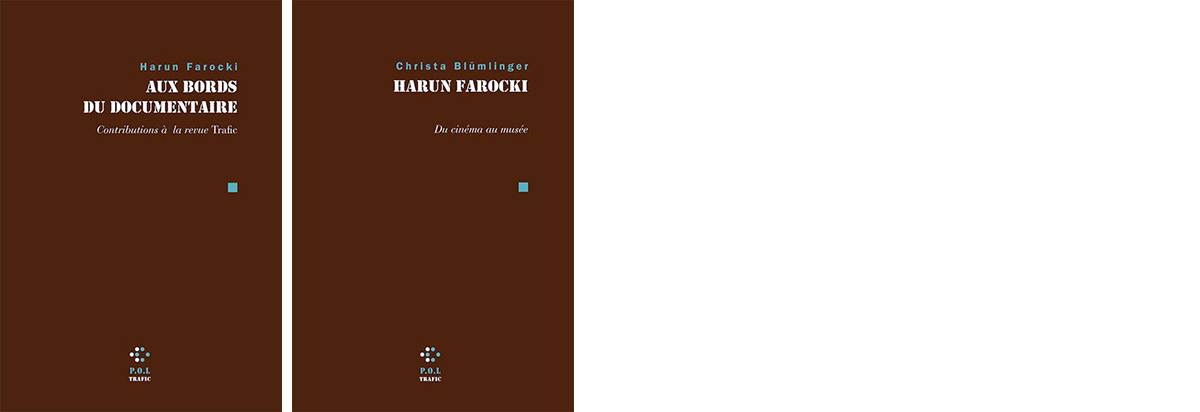
Filmmaker, essayist and artist Harun Farocki (1944-2014) has always had the habit to accompany his audiovisual work by texts, but he was also one of the most faithful contributors to the magazine Trafic, having been one of the editors of the German journal Filmkritik in the 1970s and 1980s. Since then, he has never stopped writing about cinema. The French film critic and theoretician Raymond Bellour has now collected all of Farocki’s texts published in Trafic, devoted to various aspects of cinema as well as to certain moments in the development of his own work. Some of the texts were published after his death, thanks to the complicity of his wife Antje Ehmann, who looked after his archives. In December, P.O.L. will publish Harun Farocki. Au bord du documentaire: Contributions à la revue Trafic in parallel with the writings of film teacher, critic and curator Christa Blümlinger on the work of Harun Farocki, to whom she was particularly close. The dialogue between Blümlinger and Farocki began in 1989, quickly became regular and continued until Farocki’s death in 2014 in the form of letters, public and private conversations, seminars and workshops, or in the context of programming or publications. Harun Farocki. Du cinéma au musée maps out a critical vision of his work. Following a double reflection (cinema/museum), this set of texts does not oppose cultures or dispositifs, but rather suggests the idea that Farocki ended up choosing the museum as an “other” space, site and laboratory of cinema that he had never stopped considering as an art of memory, and as an art of possibilities.
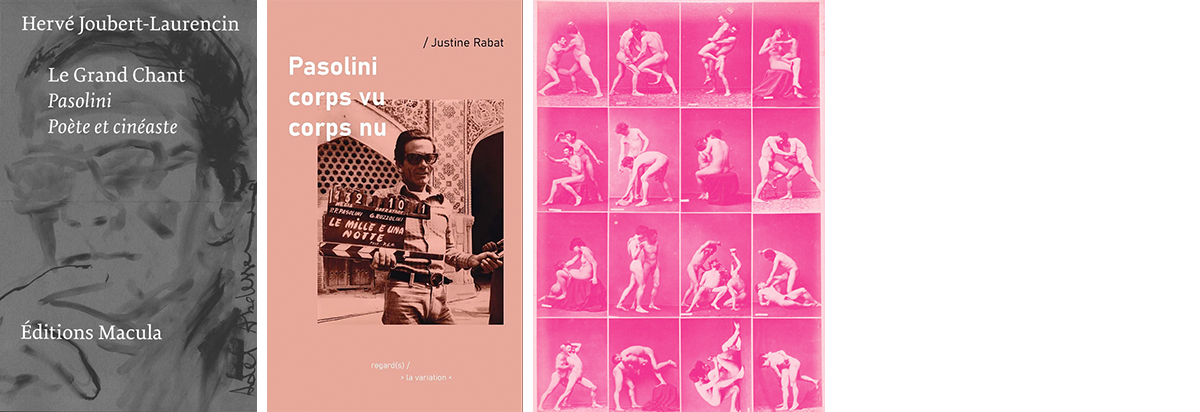
Still in the celebratory year of Pier Paolo Pasolini’s centenary, and for the first time in French, a complete chronicle of his literary and cinematographic work is published by Éditions Macula under the title Le Grand Chant. Pasolini poète et cinéaste. In this highly-informed monograph – the book counts no less than 864 pages – specialist Hervé Joubert-Laurencin takes the reader from Pasolini’s early Friulian poems to The Ashes of Gramsci, from his early Accattone as a thirty-nine-year-old to Salò, or the 120 Days of Sodom at the end of the great artist’s life at the age of fifty-three.
In the spring of 2021, a new independent publishing house saw the light of day in Paris. So far, Éditions de la variation published French translations of books by authors such as Virginia Woolf or Cesare Pavese, and an original text on cinema by Antonin Artaud. This fall, they treat us to Pasolini corps vu – corps nu, a book by Justine Rabat on the representation of the body in Pasolini’s films and in particular in his Trilogy of Life: The Decameron (1971), The Canterbury Tales (1972) and Arabian Nights (1974). Earlier this year, in June, the same publisher also launched the first issue of their new magazine, la variation. The magazine, that is free to download as a PDF, contains an interview with Justine Rabat on Pasolini’s Trilogy of Life, but also features a section dedicated to “cinéma(s)”, with among others a text by Antonin Artaud on The Marx Brothers.
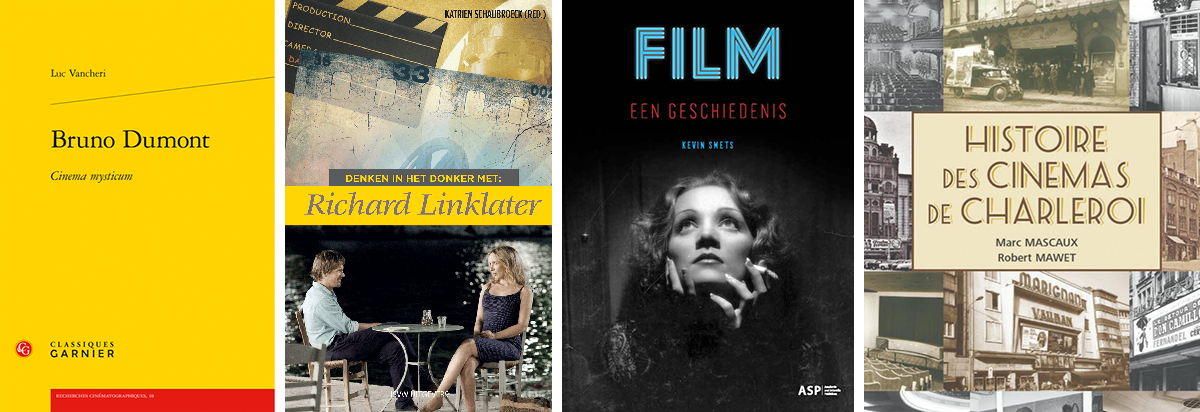
In our previous book note, we announced the publication of a monograph on Bruno Dumont’s L’Humanité (1999), to be released next month. In July, another book on the French filmmaker was published by Classiques Garnier. In Bruno Dumont: Cinema mysticum, Luc Vancheri explores Domont’s oeuvre through a philosophical lens. Most readings of Dumont tend to focus on his naturalism, thereby neglecting the mystical dimension of his films. This book aims to uncover this dimension by relating Dumont’s work to thinkers such as Charles Péguy and Henri Bergson.
‘Denken in het donker’ (‘Thinking in the dark’) is a new, Dutch book series that also looks at cinema from philosophical perspective. Published by ISVW, the books will be alternately edited by philosophers Katrien Schaubroeck and Rob van Gerwen from the University of Antwerp and Utrecht, respectively. In four essays, the first volume, Denken in het donker met Richard Linklater, sheds a philosophical light on Linklater’s films, foregrounding the concept of time as crucial to an understanding of his work. The next volumes in the series will be dedicated to the films of Andrei Tarkovsky (currently being printed), the Coen brothers (November), and Sofia Coppola (December); future editions for spring 2023 on Chantal Akerman, Agnes Varda and Nuri Bilge Ceylan are in the making.
Even more exceptional in the Low Countries, is the upcoming publication of a general film history handbook in Dutch. Professor Kevin Smets from the Free University of Brussels (VUB) took up the task with Film: een geschiedenis, an overview of 130 years of film history which combines the perspectives of politics, technology, and industry. In an attempt to develop a more open and inclusive approach to film history, it includes more non-western cinema and reflects on themes such as colonialism, sexism and discrimination. It also contains contributions by notable experts such as Raoul Servais and Claire Atherton. Published by ASP Editions, the book will be launched at CINEMATEK on October 27 with a screening of short films by Alice Guy, followed by Sunset Boulevard (1950). On October 13, Kevin Smets also presents the book at Film Fest Gent in a talk.
A last Belgian film publication presents, rather than a history of film, a history of cinemas. Histoire des cinémas de Charleroi documents the story of 23 cinemas in Charleroi and explains their impact on the city's film culture. Written by Marc Mascaux and Robert Mawet, this richly-illustrated book has been published by Les Editions Le Carnet in March.
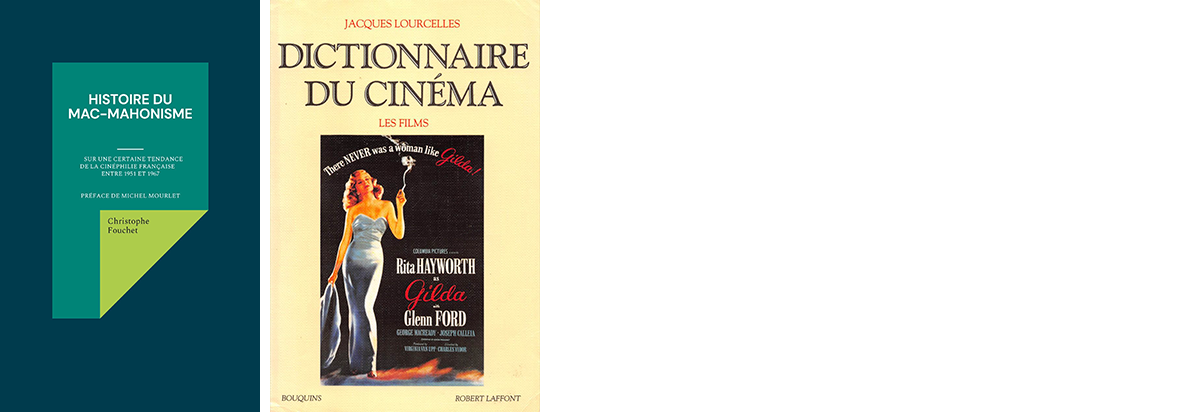
Attached to one cinema in particular, the legendary Mac Mahon in Paris, the MacMahonians have now been the subject of a first monograph on this movement as a whole. Histoire du mac-mahonisme: Sur une certaine tendance de la cinéphilie française entre 1951 et 1967 recounts the history and cultural impact of this group of cinephiles who shared a specific view on cinema. Based on archival documents and unpublished testimonies, author Christophe Fouchet explores some of the central ideas that bind the MacMahonians and that continue to inform current debates. Released last May by Books on Demand, the publication contains a preface by Michel Mourlet (1935), one of the original MacMahonians and author of their manifesto, “Sur un art ignoré”, published in Cahiers du Cinéma in 1959.
Also a MacMahonian and editor of their former journal Présence du cinéma, Jacques Lourcelles (1940) went on to compile his famous Dictionnaire du cinéma containing more than 5000 films, still a reference work for many. Originally published in 1992, the dictionnary will be republished on November 10 in a new, revised and augmented edition in Robert Laffont’s Bouquins collection, and consist of two volumes: Tome 1 - Des origines à 1950 (1384 pages) and Tome 2 - De 1951 à nos jours (1640 pages). The term “dictionary” comes with the expectation of a certain objectivity, but Lourcelles does not shy away from giving his opinion on the films he describes, especially when it comes to his love for American cinema. Lourcelles wrote the original third tome of the dictionnary (1760 pages) containing film titles and critical analyses, while the first two volumes were coordinated by Jean Tulard and focused on directors and actors, respectively.
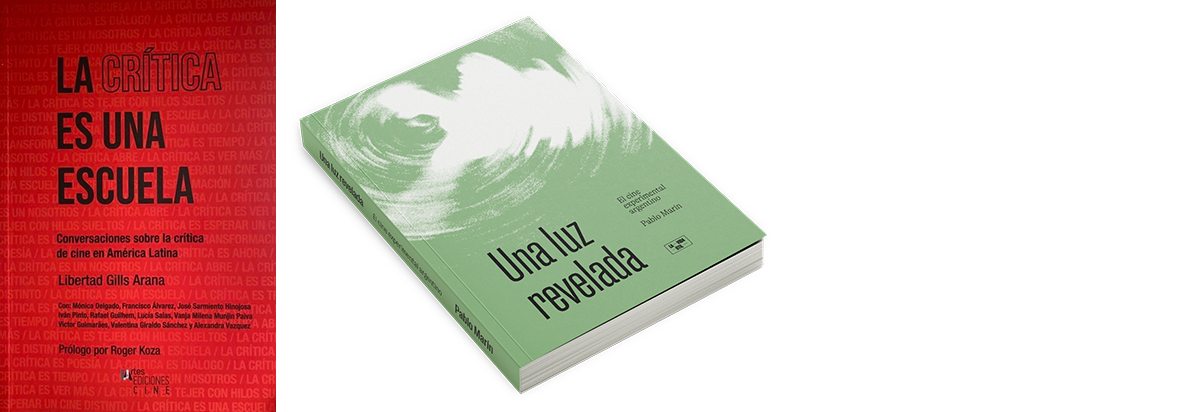
Edited by Libertad Gills Arana, La crítica es una escuela gathers discussions and new interviews on the state of film criticism in Latin America with, among others, Mónica Delgado (desistfilm), Victor Guimarães (Cinética) and Lucía Salas (La vida útil). Published by the university press UArtes Ediciones in Ecuador, this collection includes a prologue written by Roger Koza (Con los ojos abiertos). It’s available in bookstores in Ecuador, but you can write Libertad Gills for more info on how to obtain a copy. The aforementioned film magazine La vida útil also just edited their first book. With Una luz revelada. El cine experimental argentino, author Pablo Marín fills a gap and sheds light on the history, development and evolution of Argentine experimental cinema. The book will be published in both Argentina and Spain, and is in presale since September 16 through their website.
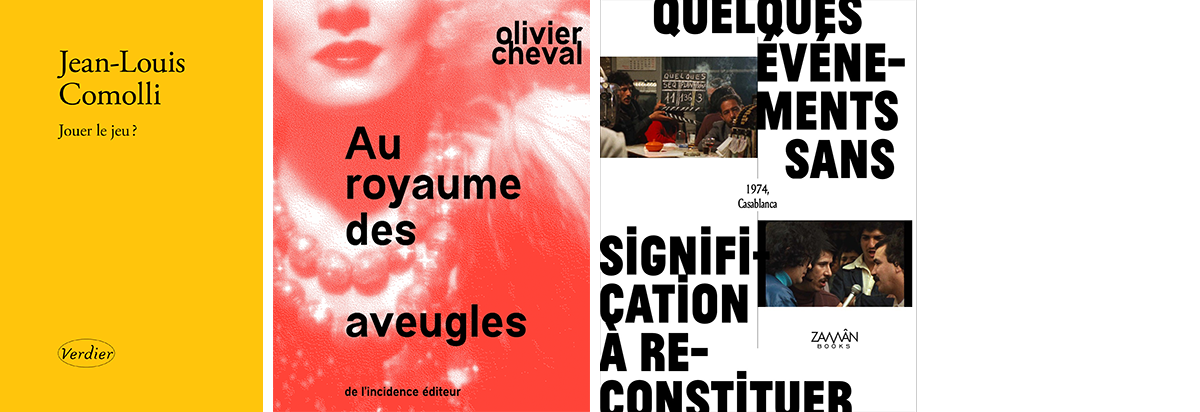
“Of Jean-Louis Comolli it can truly be said that he was a man of cinema,” Daniel Fairfax concluded in his obituary of the late French critic, film theorist and filmmaker. In May this year, the very month of his passing, Comolli published a small book called Jouer le jeu?. Death is real, Comolli understood while writing his last text. It became not just a retrospective look on a life in cinema, but an account of what remains in his days in a hospital with a shortage of staff, where his relationship with the people who care for him is mediated by the screens that surround him.
Olivier Cheval has written a kind of love letter to the otherworldly qualities of the film theater experience, framed as a “kingdom of the blind”. Divided into three chapters or movements (Desire, Passions, Promises), Au royaume des aveugles begins briefly with the initiative of critic Serge Daney to invite a blind woman to the radio studio to talk about cinema. Out with De l'incidence éditeur, this book-length essay thus deals with the relationship between sound and image, sight and its absence, colors or off-screen looks, and analyses several films that evoke or bring up moments of insight, dazzlement, but also indifference to vision.
This question of “blindness” in cinema can also be applied to the history of the first film by Moroccan filmmaker Mostafa Derkaoui, About Some Meaningless Events (1974). The film was first screened in Paris in 1975 but was immediately banned for exhibition and export by the regime of king Hassan II. It disappeared, was long forgotten and deemed lost, until only in 2016 a negative print was found and restored. Forthcoming with Zamân Books in November, De quelques événements sans signification à reconstituer presents the research that led to the film's recent resurfacing and international distribution. Far from being confined to a cinematographic history, this “book-archive, book-investigation, book-action” sketches out, from the multiple paths opened up by the film, a constellation of micro-histories which are reflections and proposals for narratives on the cultural, artistic and political Morocco of 1974. Cinema Nova in Brussels rereleases the film, sets up an exhibition and film program around the book, and a conversation with researcher and editor Léa Morin on October 16.
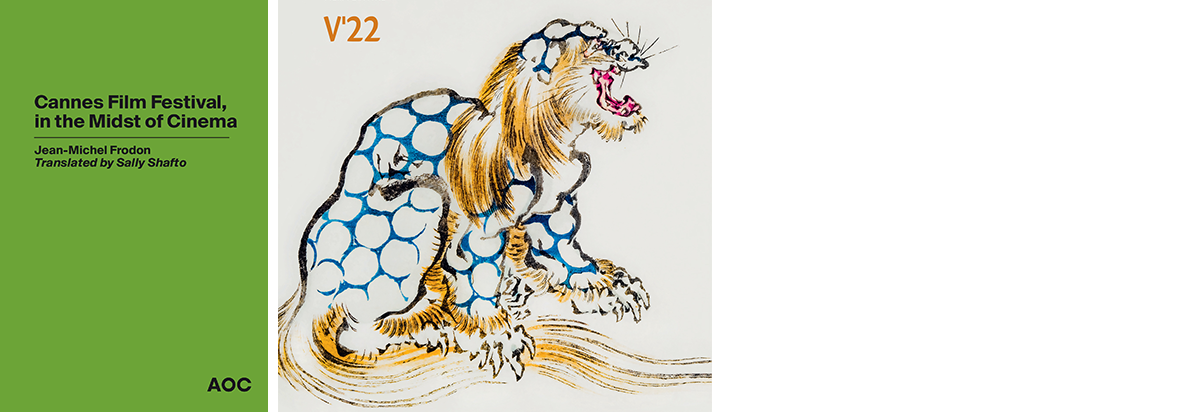
The ins and outs of the Cannes film festival are the subject of a new book by critic Jean-Michel Frodon. Cannes, “the most successful place in the world at creating a fusion of all of the many dimensions of cinema,” is defined by “artistic projects, stories to be told, money issues, technology, glamour, legends, fan-clubs, controversial subjects for debate… all of them at once.” Cannes Film Festival, in the Midst of Cinema is available in French and in an English translation by Sally Shafto. You can read an excerpt on the website of publisher AOC.
Whereas Frodon wrote the booklet on the occasion of the 75th edition of the Cannes film festival, the Viennale celebrates its 60th anniversary in October with a special publication. Viennale 60 - On Festivals brings together reflections from festival experts in the form of conversations, interviews and essays; members of the film industry share memories and experiences, discuss the past and present of the festival(s), and offer ideas and suggestions for the future. Among the contributors you can find Carlo Chatrian (Berlinale), Alberto Barbera (Venice) and Paolo Moretti, as well as colleagues from Latin America, Asia and the African Mediterranean countries.
Additionally, the Viennale will also publish not one but two new volumes in their TEXTUR series this year. TEXTUR #4 is dedicated to the Kazakh director Darezhan Omirbayev and – in line with the editorial concept of the series – features different types of texts and material. Essays, critical statements, poems and photographs, always also of the director himself, shed light on his career. One of the many authors contributing to the book is actress Isabelle Huppert, an admirer of Omirbayev’s filmmaking. TEXTUR #5 pays tribute to the work of Alain Guiraudie. It presents photos and texts by the filmmaker and writer, as well as contributions from other directors, critics and experts who believe that Guiraudie’s voice of dissent gives expression to the marginalized and the excluded of contemporary society, and does so with a fine, elegant sense of humor.
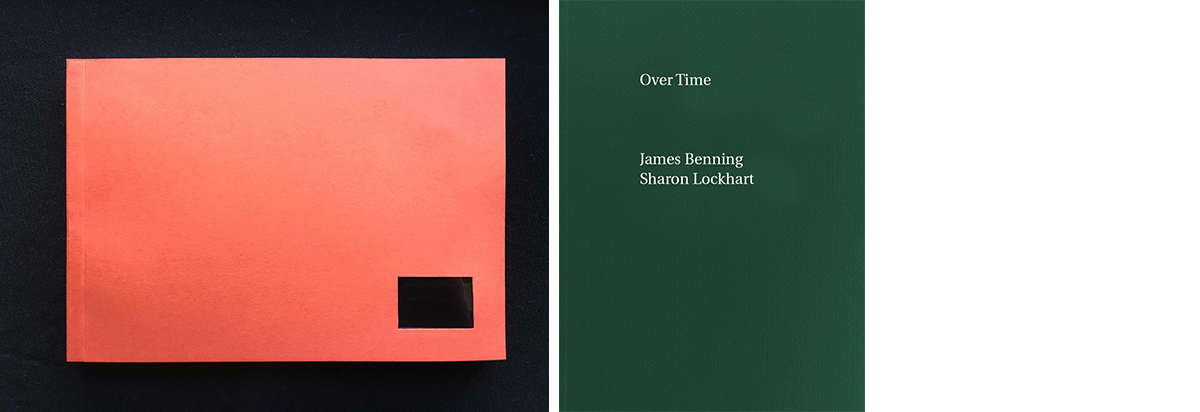
In 2012, the Spanish filmmaker and writer Alberte Pagán was asked to accompany Peter Kubelka during his time at A Corunha’s (S8) Mostra de Cinema Periférico. Informal conversations led to a first interview. Eventually, Pagán decided to make it part of a book, expanded to interviews with five more experimental filmmakers: Ken Jacobs, Taka Limura, Bill Brand, Philip Hoffman and Malcolm Le Grice. The beautifully designed and richly illustrated Emotional Materials / Personal Processes has been released this summer by Stereo Editions, an independent Marseilles-based publisher founded in 2016 and focused on artist's books, experimental film and music.
Another publication build around a profound conversation between artists, Over Time pairs works from American artists James Benning and Sharon Lockhart with a collaborative, almost stream-of-consciousness text. Benning and Lockhart often cite each other’s films as an influence on their own work. They have each made careers of investigating the structure of film itself and rethinking the use of duration and sound. Both artists’ work illustrates the importance of close observation and the evolving urban landscape. The book is edited and designed by Martin Beck and is available as of this month at Inventory Press.
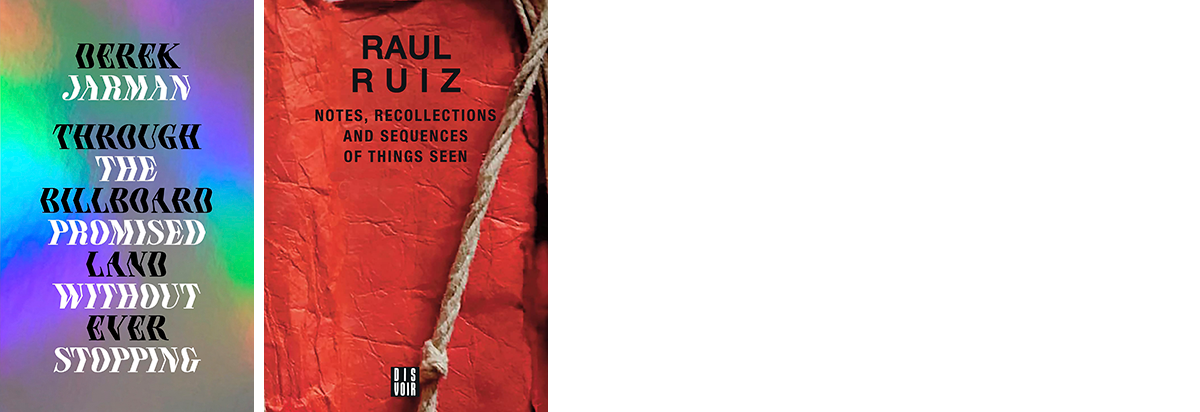
Two posthumous personal projects will be published on November 15. In 1971, a young Derek Jarman wrote his first and only piece of narrative fiction, Through the Billboard Promised Land Without Ever Stopping. The surreal tale, rich with the style and imagery of his later work, remained unpublished until now. House Sparrow Press acquired world rights for the text and audio from the estate of the late artist and filmmaker. The 10.000-word story appears in what would have been his 80th year and will be accompanied by a link to an exclusive audio recording of Jarman himself reading the full story, which he said is “autobiographical although deeply buried”.
Notes, Recollections and Sequences of Things Seen gathers diary excerpts and meditations on cinema by the celebrated Chilean experimental filmmaker Raul Ruiz. In these notes, we follow the late stage of Ruiz’s career (1990-2011), in which he realized more ambitious productions than those at the time of his seminal volumes on new narrative modes, Poetics of Cinema 1 & 2. These newer films generated significant economic and aesthetic challenges, and see Ruiz observing an increasing discrepancy between his own dream of a nonindustrial, handmade cinema and the reality he lived in. Dis Voir will simultaneously publish a French and English edition.
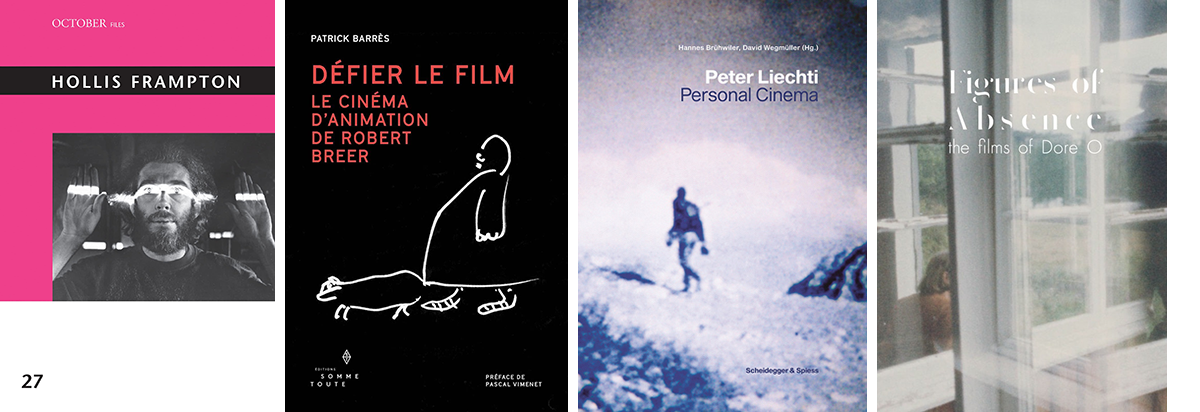
In their series of inexpensive paperbacks published through MIT Press, the editors of October journal put out the first collection of critical writing on the work of Hollis Frampton (Zorns Lemma, Lemon), one of the most important experimental filmmakers and theorists of his time. October was as central to Frampton as he was to it. He was both a frequent contributor – appearing in the first issue in 1976 – and a frequent subject of contributions by others. Some of these important and incisive writings on Frampton's work are reprinted here, including two essays by the late Annette Michelson. Hollis Frampton complements MIT Press’s 2015 On the Camera Arts and Consecutive Matters, which collected Frampton's own writings.
The work of another key filmmaker and artist of the American avant-garde, Robert Breer, is examined in a new monograph. With a career spanning 50 years across different media, Robert Breer (Eyewash, Blazes, Fuji, Recreation, A Man and his Dog Out for Air) is best known as a pioneer of experimental animated film. Published by Éditions Somme Toute, Défier le film: Le cinéma d'animation de Robert Breer focuses on the ruptures of meaning, the search for other forms of expression, the different regimes of sensation and the singular aesthetic motives at work in his films.
Take note that film restorer and researcher at the Deutsche Kinemathek Berlin, Masha Matzke, is also finishing a first monograph on Dore O., another painter-filmmaker who transformed painterly concepts into a distinctly cinematic language that alludes to but shifts the perspective of American avant-garde lyrical film styles. Dore O., who tragically passed away in early March 2022, was a co-founder of the Hamburg Co-op and actively involved in exploring new forms of cinema with her then-husband, Werner Nekes, who for too long overshadowed her own practice and contributions. Figures of Absence: The Films of Dore O. will be published by Archive Books this winter.
Also new is the first monograph dedicated to the work of the Swiss filmmaker, documentarian and author Peter Liechti (1951-2014). Published this month by Scheidegger & Spiess, Peter Liechti: Personal Cinema offers an overview of his complete works. It widens the view of his cinematic and literary work and places it in an international context. Selected texts as well as images, photos and found objects from Liechti's estate are published here for the first time ever. With contributions by Michael Sicinski and Gina Telaroli, among others.
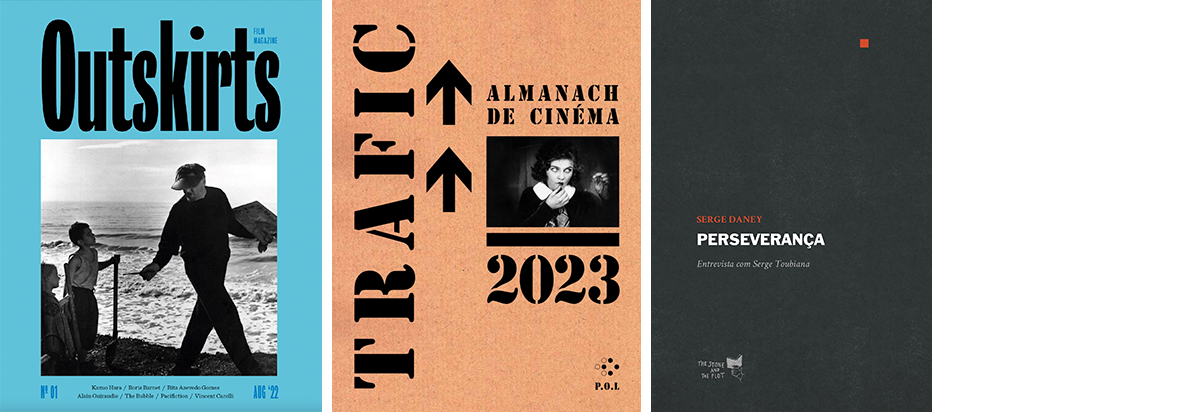
Moving on to our traditional overview of new film magazines, the first issue of Outskirts has been launched this August at the Locarno film festival. Outskirts is a new English-language biannual magazine of around 160 pages per issue, made up of original essays, interviews, reviews, translations and a single large dossier. The first dossier is dedicated to the Soviet filmmaker Boris Barnet, who’s 1933 film inspired the magazine’s title, and contains contributions from, among others, Patrick Holzapfel, Srikanth Srinivasan, Lucía Salas, Dan Sallitt, Roger Koza, Boris Nelepo, and an interview about Barnet with Pierre Léon conducted by one of the magazine’s four editors, Christopher Small. The inaugural issue has already sold out, but you can still order and it’ll be dispatched as soon as they have a second run of the magazine, already estimated to happen early October. A new ambitious and international film journal with a great team behind it is a reason to rejoice. In support, you can also order the first two issues, the second one being estimated for February 2023.
Also featuring a Boris Barnet photogram on the cover, Trafic will live on in a new annual “almanac” format. After 30 years and 120 issues, the French film quarterly is shifting to a collective yearbook, with the first volume to appear in December, still published by P.O.L. and without images inside. The team is largely renewed and consists of Raymond Bellour, Bernard Benoliel, Christa Blümlinger, Jean-Paul Fargier, Judith Revault d’Allonnes and Jean-Luc Mengus-Peyle. With more than 300 pages, the table of contents of the first Trafic. Almanach de cinéma contains too many promising material to sum up. One of the highlights includes the first and unpublished text that Jacques Rancière devoted to cinema in 1961 and was rejected by Cahiers.
In the first Almanach, Pierre Eugène will also present four recently rediscovered texts of Serge Daney (“Ornette à la Mutualité”, “Actualité de Rohmer”, “La star à deux têtes”, “Télé: gardiennage et maintenance”). In the meantime, Eugène's own long-anticipated, 600-page book on Daney has found a release date but not yet a cover. Serge daney, exercice de relectures - exercices de relecture will be published on November 24 by L’Extreme contemporain.
And still more Serge Daney news in this 30th year since his passing. While Semiotext(e)’s The Cinema House and the World currently gathers much attention and reactions, news hit that writer and former New York correspondent for Cahiers, Nicholas Elliott, is translating Serge Daney’s La Rampe for the same publisher. Originally published in 1983 as his first collection of film criticism, La Rampe contains a selection of articles that Daney wrote for Cahiers between 1970 and 1982. You can find Laurent Kretzschmar's existing English translations from the book here.
To conclude on Serge Daney (for now), his cine-biography, Perseverance, has now also been translated in Portuguese as Perseverança. Orginally published in 1994, Perseverance takes the form of a long interview with Daney by Serge Toubiana. Published by The Stone and The Plot, Perseverança is completed with an afterword by a friend of Daney, the Portuguese producer Paulo Branco.
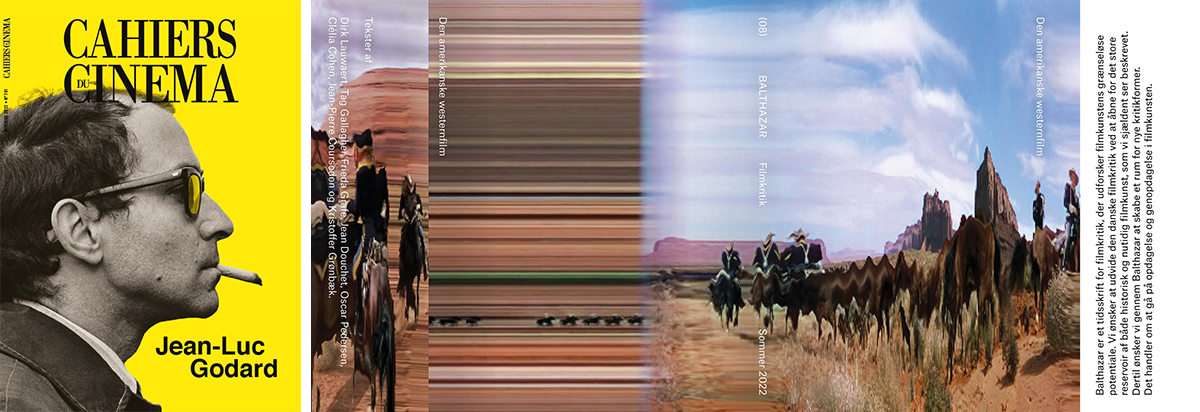
To end, we break the rule and mention four issues from magazines that are not new, but are special editions. On the occasion of Jean-Luc Godard's passing, Cahiers du Cinéma publishes a 100-page special issue. With a cover referencing the period of the Cahiers “jaunes”, this collector’s item will include testimonies, analyses, pieces from the Cahiers archive, unpublished documents, interviews with friends and collaborators, tributes from filmmakers, such as Martin Scorsese, Leos Carax, Jim Jarmusch, F.J. Ossang and Claire Denis, but also contributions from former Cahiers editors, such as Jean Narboni, Alain Bergala, Antoine de Bæcque and Charles Tesson. Available as of September 30, the issue can already be pre-ordered on the magazine's website.
Launched last month, the eight issue of the Danish film journal Balthazar is a special edition on the American western film. It features translations of texts by, among others, Tag Gallagher, Jean Douchet and Jean-Pierre Coursodon, but also by the German and Belgian critics Frieda Grafe and Dirk Lauwaert. The latter’s text on the western is also available on Sabzian in English, next to other translations of the work of Grafe.
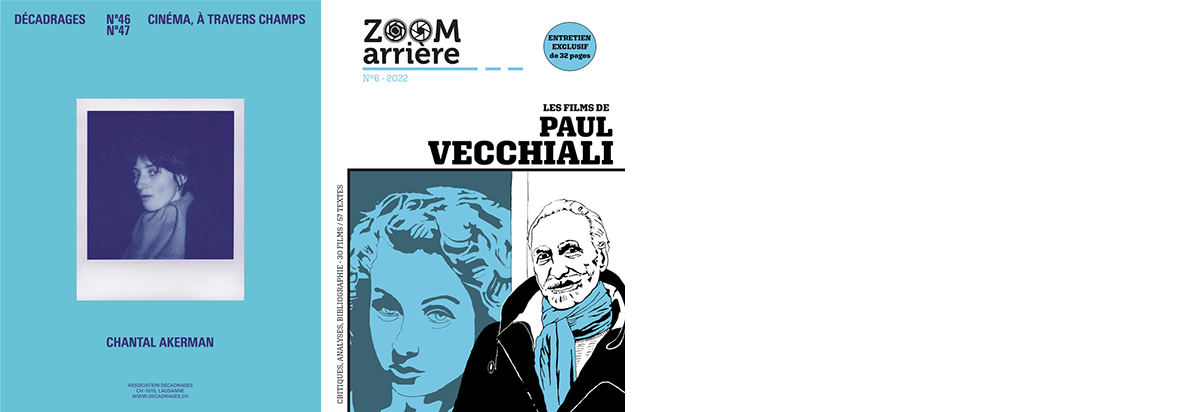
The Swiss, biannual online and print magazine Décadrages devoted its latest issue (n° 46-47) to the cinema of Chantal Akerman. The issue opens with a visual contribution by the Belgian filmmaker Boris Lehman, based on photographs he took and photograms taken from Akerman's films. The dossier is articulated through three sets of texts or registers of writing: testimonies from close friends or collaborators of Akerman, in this case Boris Lehman who recalls his relationship with the filmmaker and the operator Babette Mangolte who analyses her films and the role of music, academic essays by international researchers, and interviews with Claire Atherton, Akerman’s editor. Most of the contributions focus on Akerman’s films, whether documentaries, experimental films, fictions or adaptations. In addition, her installations, which re-articulate her own films, are also examined.
After a difficult 2021 with only one print publication and an uncertain future, the blog and collective Zoom Arrière is back with a new print publication, and a new organization, coordinator and team of writers. Last month, they published their sixth book, entirely devoted to the French filmmaker Paul Vecchiali. In fifty-seven texts by thirteen contributors, a filmography, a bibliography and an exclusive thirty-two page interview, his prolific and independent work is discussed, from his first lost film, Les Petits Drames in 1961, to his latest Pas... de quartier, that was released last April.
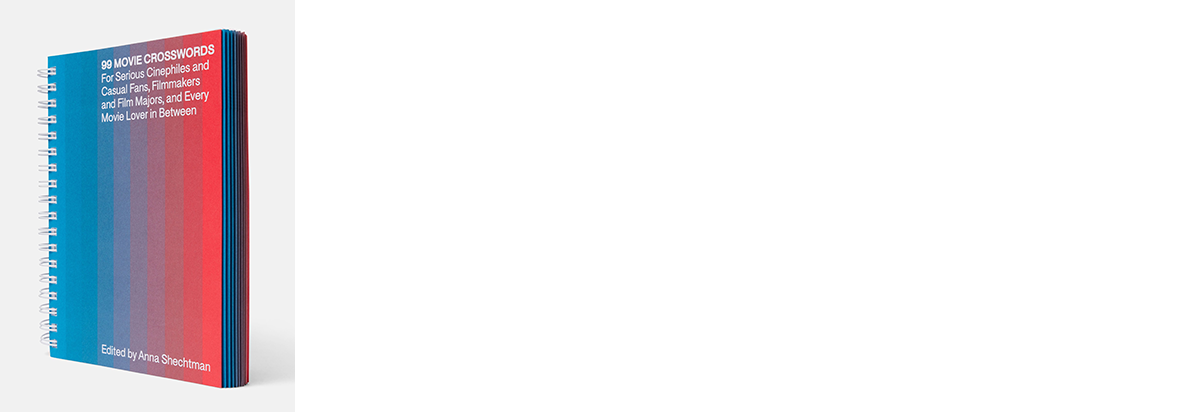
We go out with something more light-hearted. Published by A24 last month, 99 Movie Crosswords contains film puzzles that progress from easy to hard across both difficulty and movie IQ, with themes ranging from ‘As Godard said...’, ‘Syndromes and a Century’ or ‘Monkey Business’, and including special crosswords made in collaboration with filmmakers such as David Lowery (on Twin Peaks) or Tim Heidecker (‘Deee-rectors!’). It’s already sold out.

